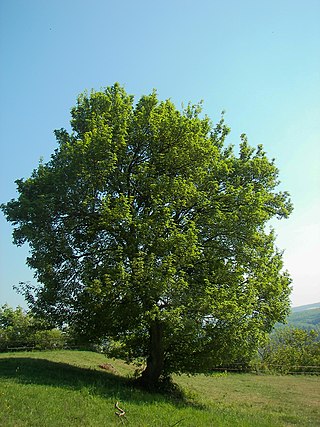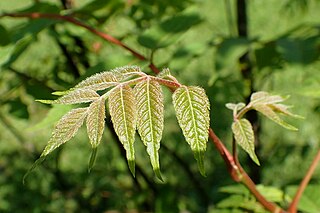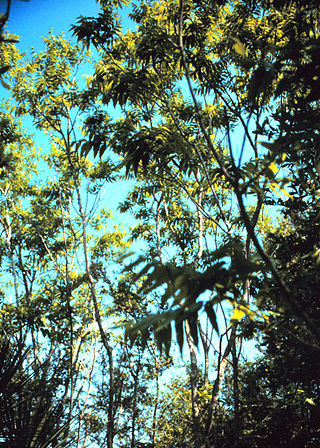
Sapindales is an order of flowering plants. Well-known members of Sapindales include citrus; maples, horse-chestnuts, lychees and rambutans; mangos and cashews; frankincense and myrrh; mahogany and neem.

Meliaceae, the mahogany family, is a flowering plant family of mostly trees and shrubs in the order Sapindales.

The Rutaceae is a family, commonly known as the rue or citrus family, of flowering plants, usually placed in the order Sapindales.

Aceraceae were recognized as a family of flowering plants also called the maple family. They contain two to four genera, depending upon the circumscription, of some 120 species of trees and shrubs. A common characteristic is that the leaves are opposite, and the fruit a schizocarp.

Melicoccus bijugatus is a fruit-bearing tree in the soapberry family Sapindaceae, native or naturalized across the New World tropics including South and Central America, and parts of the Caribbean. Its stone-bearing fruits, commonly called quenepa or guinep, are edible. These fruits have various other names such as Limoncillo, Bajan ackee, Spanish lime or mamoncillo, among numerous other common names.

Dipteronia is a genus with two living and one extinct species in the soapberry family Sapindaceae. The living species are native to central and southern China, The fossil species has been found in Middle Paleocene to Early Oligocene sediments of North America and China.

The ackee, also known as acki, akee, or ackee apple, is a fruit of the Sapindaceae (soapberry) family, as are the lychee and the longan. It is native to tropical West Africa. The scientific name honours Captain William Bligh who took the fruit from Jamaica to the Royal Botanic Gardens in Kew, England, in 1793. The English common name is derived from the West African Akan akye fufo.

The genus Aesculus, with species called buckeye and horse chestnut, comprises 13–19 species of flowering plants in the family Sapindaceae. They are trees and shrubs native to the temperate Northern Hemisphere, with six species native to North America and seven to 13 species native to Eurasia. Several hybrids occur. Aesculus exhibits a classical Arcto-Tertiary distribution.

Paullinia is a genus of flowering shrubs, small trees and lianas in the soapberry family, Sapindaceae and typical of tribe Paullinieae. It is native to tropical South America, Central America and the Caribbean.

Sapindus is a genus of about thirteen species of shrubs and small trees in the lychee family, Sapindaceae and tribe Sapindeae. It is native to warm temperate to tropical regions of the world. The genus includes both deciduous and evergreen species. Members of the genus are commonly known as soapberries or soapnuts because the fruit pulp is used to make soap. The generic name is derived from the Latin words sapo, meaning "soap", and indicus, meaning "of India".

The Burseraceae are a moderate-sized family of 17-19 genera and about 540 species of woody flowering plants. The actual numbers given in taxonomic sources differ according to taxonomic revision at the time of writing. The Burseraceae are also known as the torchwood family, the frankincense and myrrh family, or simply the incense tree family. The family includes both trees and shrubs; its species are native to tropical regions of Africa, Asia, Australasia, and the Americas.

Aesculus flava, also known commonly as the common buckeye, the sweet buckeye, and the yellow buckeye, is a species of deciduous tree in the subfamily Hippocastanoideae of the family Sapindaceae. The species is native to the Ohio Valley and Appalachian Mountains of the Eastern United States. It grows in mesophytic forest or floodplains, generally in acid to circumneutral soil, reaching a height of 20m to 48m.

Acer is a genus of trees and shrubs commonly known as maples. The genus is placed in the soapberry family, Sapindaceae, along with lychee and horse chestnut. There are approximately 132 species, most of which are native to Asia, with a number also appearing in Europe, northern Africa, and North America. Only one species, Acer laurinum, extends to the Southern Hemisphere. The type species of the genus is the sycamore maple, Acer pseudoplatanus, the most common maple species in Europe. Maples usually have easily recognizable palmate leaves and distinctive winged fruits. The closest relatives of the maples are the horse chestnuts. Maple syrup is made from the sap of some maple species. It is one of the most common genera of trees in Asia. Many maple species are grown in gardens where they are valued for their autumn colour.

Hippocastanoideae is a subfamily of flowering plants in the soapberry family Sapindaceae. The group was formerly treated as the separate families Aceraceae and Hippocastanaceae. Molecular phylogenetic research by Harrington et al. (2005) has shown that while both the Aceraceae and Hippocastanaceae are monophyletic in themselves, their removal from the Sapindaceae sensu lato would leave Sapindaceae sensu stricto as a paraphyletic group, particularly with reference to the genus Xanthoceras.

Dipteronia sinensis is a plant species in the genus Dipteronia, endemic to mainland China, and regarded in the soapberry family Sapindaceae sensu lato after Angiosperm Phylogeny Group and more recently ), or traditionally by several authors in Aceraceae, related to the maples.

Aesculus chinensis, the Chinese horse chestnut or Chinese buckeye, is a deciduous temperate tree species in the genus Aesculus found across China. It was first successfully introduced to Britain in 1912 by plant collector William Purdom, who collected six young plants from the grounds of a temple in the western hills of Beijing, and brought them back to Veitch's Nursery in Coombe Hill near London. Purdom's correspondence regarding this event are held in the archives of the Arnold Arboretum. One plant was sent to the Royal Botanic Gardens Kew and two to the Arnold Arboretum in Boston. The original tree at Kew no longer exists but a young tree grafted from the original now grows in the Rhododendron Dell.

Sapindoideae is a subfamily of flowering plants in the soapberry family, Sapindaceae. It includes a number of fruit trees, including lychees, longans, rambutans, and quenepas.

























